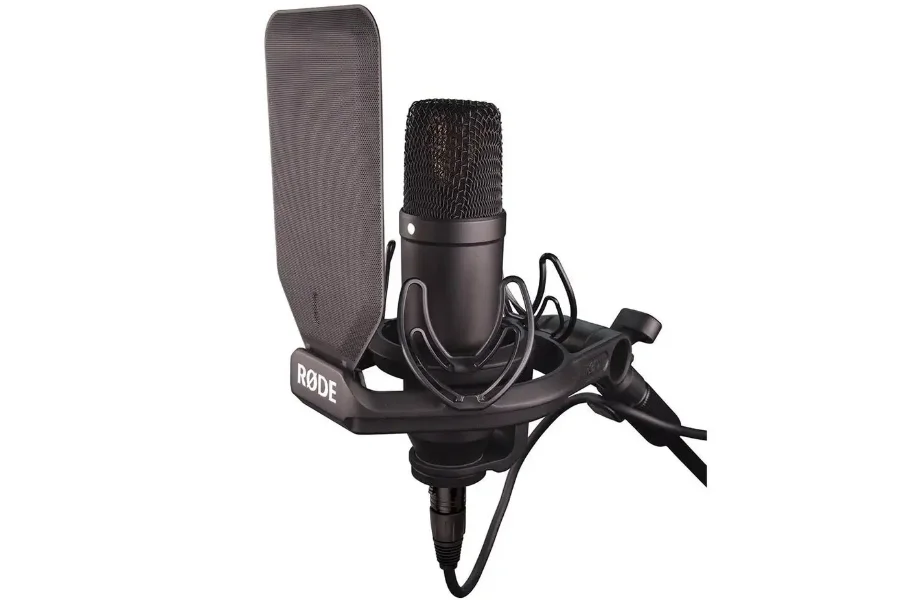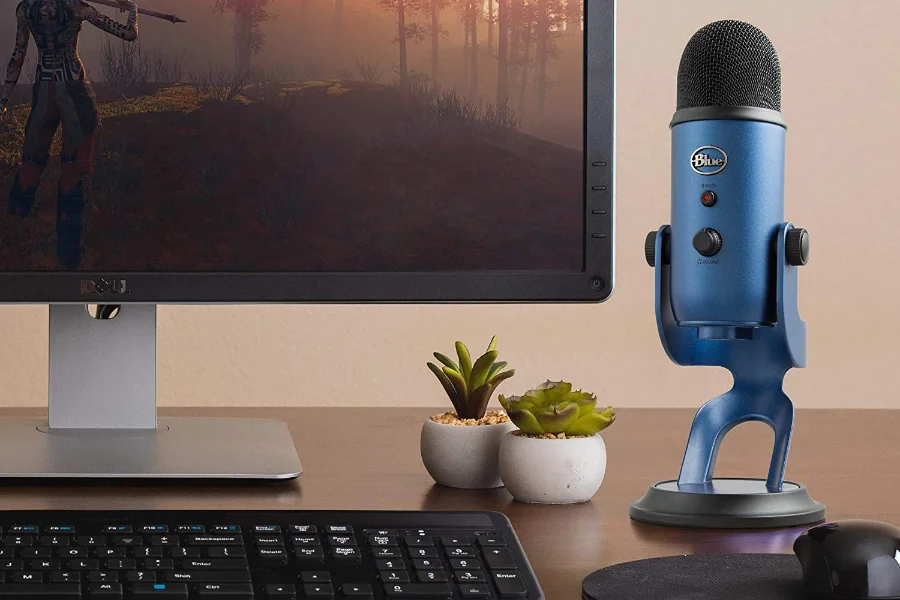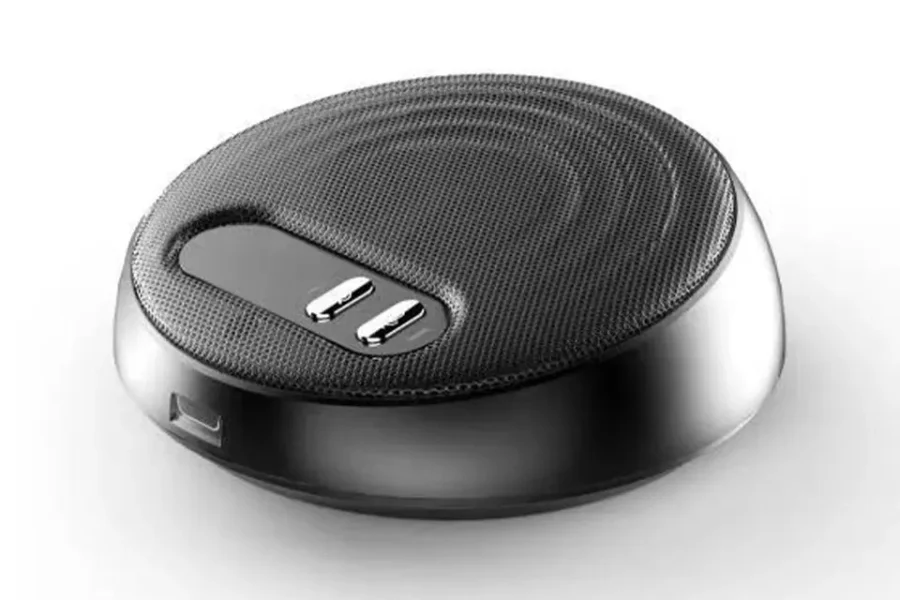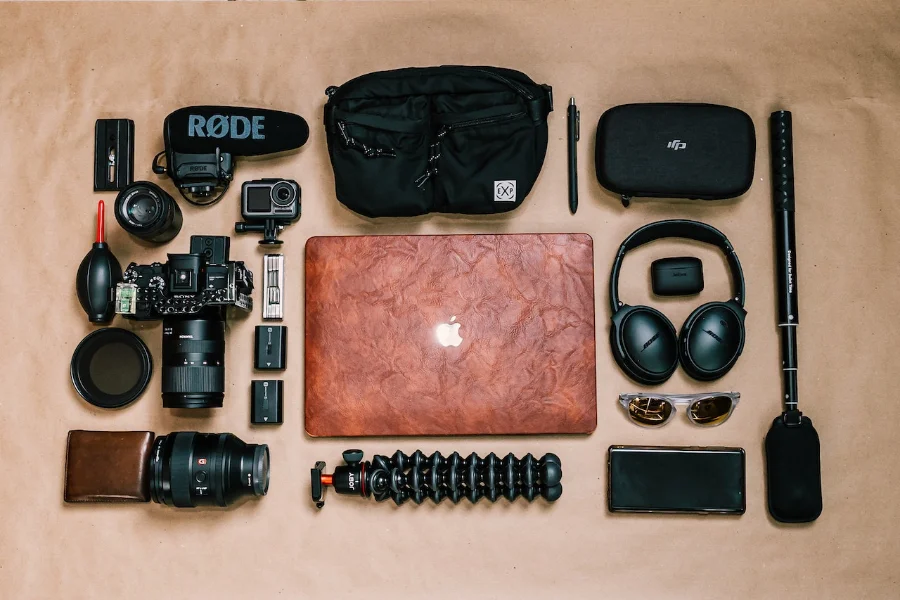Businesses selling gadgets like microphones should understand specific microphones for podcasting to better target their marketing efforts and tailor their product offerings to podcasters.
Understanding the features of podcasting microphones gives businesses a competitive advantage in a saturated market. It allows them to provide personalized recommendations and guidance, leading to customer satisfaction and retention. By showcasing their expertise, businesses can build trust, credibility, and long-term relationships with podcasters, positioning themselves as trusted advisors and go-to sources for podcasting equipment
Additionally, businesses that cater to podcasters’ needs may have opportunities for partnerships, sponsorships, and collaborations within the podcasting industry.
Table of Contents
The market for podcasting technology
Why is a good podcasting microphone important?
Understanding microphone types
Factors to consider when choosing microphones for podcasting
So, what’s the verdict?
Best podcast microphones for all budgets
Other equipment to consider as part of a podcast setup
Final thoughts on podcasting microphones
The market for podcasting technology
The podcasting industry has experienced significant growth in recent years, driven by increasing consumer demand for on-demand audio content. In 2023, the number of podcast listeners reached 464.7 million. There are over 5 million podcasts globally, with over 70 million episodes between them. Last year alone, almost 30 million podcast episodes were published, with the US producing approximately 60% of the podcasts.
43% of podcast listeners aged 35-54 are monthly podcast listeners (the most popular age group for podcast consumption). And overall, podcasting has reached the highest numbers ever, with 90 million Americans being weekly podcast listeners.
Overall, the podcast industry market size is $23.56 billion.

Why is a good podcasting microphone important?
A good podcasting microphone is crucial for several reasons:
1. It ensures high sound quality, capturing your voice accurately while minimizing background noise. This enhances the overall production value and credibility of your podcast.
2. Clear audio promotes listener engagement, keeping them focused on your content and encouraging repeat listening.
3. It signals professionalism and dedication to delivering top-notch content, attracting new listeners and building your podcast’s reputation. A good microphone also offers versatility, allowing you to record in various environments without compromising sound quality.
4. It simplifies editing and post-production by providing clean audio with minimal distortion.
5. Investing in a quality microphone future-proofs your setup, allowing you to upgrade other components while maintaining a solid foundation.
Overall, a good podcasting microphone is an essential investment that enhances the audio experience for customers and their audience, ensuring professionalism and engagement in the podcasting world.
Understanding microphone types
The most common microphones used for podcasting are dynamic, condenser, USB, and lavalier. Let’s talk about how each of these microphones works and the pros and cons of each for podcasting.
Dynamic microphones
Dynamic microphones operate on the principle of electromagnetic induction. Inside the microphone is a diaphragm attached to a coil of wire. When sound waves hit the diaphragm, it vibrates, causing the coil to move within a magnetic field. This movement generates an electrical current proportional to the sound waves’ amplitude.
The electrical signal is then sent through the microphone’s output connector, which can be connected to an audio interface or mixer for recording or broadcasting.
Dynamic microphones are popular for podcasting due to their durability, versatility, and ability to handle high sound pressure levels. They are less sensitive to background noise and are great for recording in less controlled environments. Dynamic microphones, such as the Shure SM58, Fifine K669D XLR, and Gk59 Havit, are widely used in podcasting.
Condenser microphones
Condenser microphones work based on changes in capacitance. They consist of a diaphragm, which acts as one capacitor plate, and a backplate, which acts as the other plate. The diaphragm and backplate are separated by a small air gap.
When sound waves hit the diaphragm, it vibrates, causing the distance between the diaphragm and the backplate to change, resulting in a change in capacitance. This variation in capacitance generates an electrical signal proportional to the sound waves.
Condenser microphones require an external power source, usually phantom power from an audio interface or mixer, to polarize the diaphragm and provide the necessary voltage for operation.
Popular condenser microphones used in podcasting include the Audio-Technica AT2020, Fifine A6T, and Rode NT1.
USB microphones
USB microphones are typically condenser microphones with built-in analog-to-digital converters (ADC) and USB interfaces. They are designed to directly connect to a computer or laptop via a USB port.
The microphone capsule captures sound waves and converts them into an analog electrical signal. This signal is then converted to a digital signal by the internal ADC within the microphone, eliminating the need for additional audio interfaces or converters.
The digital signal is sent via the USB connection to the computer, where it can be recorded or used for live streaming, podcasting, or other audio applications.
Blue Yeti is a common USB microphone choice as it is a plug-and-play device with decent sound quality and ease of use.
Lavalier microphones
Lavalier microphones are typically small condenser microphones designed to be clipped onto clothing close to the speaker’s mouth. They work similarly to regular condenser microphones, where the diaphragm captures sound waves and converts them into electrical signals.
Lavalier microphones often have a thin cable that connects to a bodypack transmitter, which wirelessly sends the audio signal to a receiver connected to a recording device or mixer. In some cases, lavalier microphones can directly connect to a recording device or mixer through a wire.
They are discreet and provide good sound quality for individual speakers. Lavalier microphones like the Rode SmartLav+ are popular choices for podcasters on the move.
| Pros | Cons | |
| Dynamic microphones | Durability: They are sturdy and can handle rough handling without distortion. Background noise: They have a focused pickup pattern which helps reject background noise. Versatility: They work well in various recording environments, including outdoor settings. |
Sensitivity: They are less sensitive than condenser microphones, requiring closer proximity to the sound source for optimal capture. Detail: They may capture less detail or high-frequency nuances than condenser microphones. |
| Condenser microphones | Sensitivity & detail: They are more sensitive and capture a broader frequency range, resulting in detailed and accurate audio reproduction. Versatility: They come in various polar patterns (e.g., cardioid, omnidirectional) to suit different recording situations. |
Fragility: They are more delicate and require careful handling. Background noise: They arding on their phonere more sensitive to background noise. Power requirement: Many require phantom power, which adds to the setup complexity. |
| Lavalier microphones | Portability & convenience: They are small, lightweight, and easily clip onto clothing, providing convenience and mobility. Hands-free operation: They allow for hands-free recording, which can be beneficial in interviews or situations where mobility is necessary. Discreet: They are less visually intrusive and can create a more natural and relaxed recording environment. |
Sound quality: They likely will not match the sound quality of dedicated studio microphones. Placement limitations: Positioning is critical for optimal sound capture; improper placement can result in muffled or inconsistent audio. Limited range: They have a limited capture range and may not perform as well for capturing distant or ambient sounds. |
| USB microphones | Easy setup: Convenient and user-friendly, they typically offer plug-and-play functionality, allowing you to connect them directly to your computer or laptop via a USB port without additional audio interfaces or converters. Portability: They are compact and portable, making them convenient for those who need to record on the go or in different locations. Cost-effective: They are more affordable compared to professional-grade XLR microphones and audio interfaces. Direct digital connection: They have built-in analog-to-digital converters (ADC), allowing them to convert the analog audio signal into a digital format within the microphone. This direct digital connection helps maintain a clean and high-quality audio signal without needing external converters. |
Limited upgradeability: They cannot be easily integrated into more advanced audio setups. Audio quality limitations: They generally do not match the sound fidelity and versatility level provided by professional XLR microphones. Lack of control: They provide limited control options compared to XLR microphones. They may have basic settings for volume, gain, and polar patterns, but advanced controls like multiple polar patterns or adjustable low-cut filters are often absent. Potential latency issues: They rely on the computer’s processing power and may introduce latency (a delay between speaking and hearing the audio) during recording or monitoring. |
Each type of microphone has its advantages and disadvantages, and the choice depends on factors such as the recording environment, intended use, budget, and personal preference. It is essential to consider the specific needs of your podcast and select a microphone that best suits your requirements.

Factors to consider when choosing microphones for podcasting
When choosing a microphone for podcasting, there are several factors to consider:
#1 – Microphone type
As previously discussed, different microphones are commonly used in podcasting, and each is best suited to different types of podcasting and setups. It is important to consider which will fit your specific needs.
#2 – Sound quality
Look for a microphone that accurately captures your voice and produces clear, natural-sounding audio. Consider the microphone’s frequency response, which indicates the range of frequencies it can capture.
A flat or neutral frequency response is often preferred for podcasting, as it reproduces your voice without adding any coloration or distortion. Additionally, pay attention to the microphone’s signal-to-noise ratio, which determines how well it captures your voice while minimizing background noise.
#3 – Connection type
Most podcasting microphones connect to your recording device or computer via USB or XLR. USB microphones are convenient and easy to set up, as they can be plugged directly into your computer without needing an additional audio interface. XLR microphones, on the other hand, require an audio interface but offer higher audio quality and more flexibility for adjusting settings and using professional audio equipment.
#4 – Budget
Consider your budget and find a microphone that offers a good balance between price and quality. Microphones are available at various prices, so it is possible to find a suitable option regardless of your budget. Investing in a higher-quality microphone can result in better sound quality and extended durability.
#5 – Recording environment
Consider the environment in which your customers will be recording. If they are recording in a noisy or untreated room, a dynamic microphone may be a better choice as it can reject background noise and focus on capturing your voice. A condenser microphone may provide more detail and accuracy if they have a well-treated studio or quiet recording space.
#6 – Portability
If they plan to record podcasts on the go or outside of a traditional studio setting, consider the portability of the microphone. Lavalier microphones or compact USB microphones can be more convenient for mobile recording.
#7 – Compatibility and setup
Ensure you offer customers microphones that are compatible with their recording device or computer. Check the system requirements and ensure it works with their preferred recording software. Additionally, consider the ease of setup and any additional equipment they may need.
So, what’s the verdict?
Condenser vs dynamic
– Recording in a noisy environment and intending to reduce background noise requires a dynamic microphone.
– Capturing very delicate sounds within a quiet setting requires a condenser microphone.
If your customers are starting and may scale in the future:
Consider offering a microphone with both USB and XLR connections now, and an audio interface in the future. Good options are the Audio-Technica ATR2100x and the Samson Q2U.
These two microphones are relatively affordable and perfect for customers to grow into their podcasting careers. With both a USB and XLR connection, they can use the same microphone should they upgrade from a USB setup to an XLR + audio interface setup.
Best podcast microphones for all budgets
Now that you have a better understanding of the different types of microphones, here are some of the best microphones for all budgets. Consider stocking these microphones to appeal to a wide range of consumers.
Shure SM58 – Dynamic microphone for beginners

The Shure SM58 is a great microphone for podcasters that are going to be out and about because it is nearly indestructible for a reasonable price. (Do not forget to offer a digital recorder like the Zoom 6 too). It works in the studio (or other location) mounted on a stand.
Shure SM7b – Best dynamic microphone

If you like the Shure microphones but are looking for the highest quality, look no further than the Shure SM7b. This microphone is legendary in the industry, but the downside is that it needs a professional studio environment as it picks up a lot of background noise (it is also unforgiving with bad mic technique).
Rode NT1 – Condenser microphone

The Rode NT1 is a great option for new podcasters as it is a reasonably-priced quality microphone that also comes with a pop shield and stand.
Those who are a fan of the Rode NT1 may also be interested in the Rode NT-USB mini, as the USB connection makes it incredibly easy to use and you can plug more than one microphone in at a time for recording multiple people. A bonus with Rode is its free Connect software that makes it easy to record two microphones in multitrack.
Blue Yeti – USB microphone

The Blue Yeti microphone is one of the most popular microphones for podcasting and for good reason. It offers great quality audio with its condenser capsules, it is easy to use thanks to its USB connection, and it also comes with its own stand. This fantastic podcasting microphone has settings for solo recording, face-to-face recording, and group recording; however, you need to be fairly close to the mic to ensure quality.
Another great option is the Fifine K678 Professional USB Microphone.
Rode Smartlav+ – Best lavalier microphone for beginners

The Rode SmartLav+ is a small clip-on mic that is perfect for beginners who are recording on their phones.
Overall, the quality is decent, and its size means it is versatile for those impromptu interviews. A bonus is that you can offer adapters for your customers to hook up two microphones to one smartphone.
Zimhome New ZTM26 – Omnidirectional microphone (USB)

The Zimhome New ZTM26 is a great USB omnidirectional microphone for beginners.
Omni-directional microphones are beneficial for podcasting situations that involve multiple speakers, group recordings, or the need for a more ambient and natural sound. They offer convenience, versatility, and the ability to capture immersive audio experiences, making them a valuable tool for podcasters seeking a more relaxed and inclusive recording setup.

Another great option to consider is an all-in-one kit built specifically for podcasters.
Other equipment to consider as part of a podcast setup
In addition to a microphone, here are some other essential equipment and tools your customers may need when starting a podcast:
– Headphones: A good pair of closed-back headphones is essential for monitoring your audio while recording and editing. They help you identify background noise, audio inconsistencies, or technical issues.
– Pop filter: A pop filter is a screen placed in front of the microphone to minimize plosive sounds (such as “p” and “b” sounds) that can cause distortion. It helps ensure a clean and clear audio recording.
– Mic stand or boom arm: A stable microphone support system is crucial for consistent audio quality and comfortable positioning. A desktop mic stand or boom arm allows you to position the microphone at the right height and angle. (You can also get a desktop pic stand with a built-in pop filter.)
– Shock mount: A shock mount helps isolate the microphone from vibrations and handling noise, reducing unwanted sounds that may occur when you adjust the mic or accidentally bump the stand. It improves the overall sound quality and eliminates disturbances. (You can also get a shock mount with a built-in pop filter.)
– Audio interface: If you are using an XLR microphone, an audio interface is necessary to connect the microphone to your computer. The interface converts the analog signal from the microphone into a digital signal that can be recorded or streamed.
– Acoustic treatment: Advise your customers to add acoustic treatment to their recording space to achieve better sound quality. This can include sound-absorbing panels, bass traps, and diffusers, which help reduce echoes, reverberation, and background noise.
Remember that while these tools can enhance the podcasting experience, customers can start with the basics and gradually expand their equipment as their podcast grows. They should focus on delivering valuable content and slowly invest in equipment that aligns with their needs and budget.

Final thoughts on podcasting microphones
The growing popularity of podcasting has created a significant demand for high-quality audio equipment. Businesses selling microphones should prioritize understanding the specific microphones used for podcasting and stocking a variety of options. By catering to this niche market, microphone sellers can tap into a thriving industry and establish themselves as trusted sources of podcasting technology.
Each podcaster has unique preferences and requirements based on their recording environment, budget, and desired audio quality. Therefore, understanding the microphones used for podcasting is essential because it enables businesses to provide informed customer recommendations.
Stocking a variety of microphones is equally important. Some podcasters may prefer the durability and versatility of dynamic microphones, while others may prioritize the superior sound quality of condenser microphones. USB microphones provide convenience and portability, appealing to podcasters on the move. By offering a range of options, businesses can ensure that they have a microphone to meet every podcaster’s specific requirements and preferences.
Podcasting is a dynamic and ever-evolving field, with podcasters constantly seeking to improve their audio quality and upgrade their equipment. By providing a diverse selection of microphones, businesses enable podcasters to find the perfect microphone for their current needs and offer the flexibility to upgrade or experiment with different options in the future.




